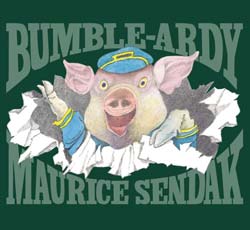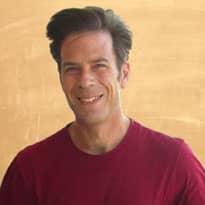 The plot of Maurice Sendak's latest children's book, Bumble-Ardy, which the old master has managed to put out at the age of 83, reads like The Basketball Diaries. In The Atlantic, Joe Fassler summarizes: "Bumble-Ardy, a young pig, is an orphan. Even worse, our hero has never in his life enjoyed a birthday party . . . when his parents are sent off to the slaughterhouse, Bumble's sweet Aunt Adeline adopts him, and gives him his first modest party . . . Left to his own devices, Bumble invites nine hedonistic, brine-guzzling swine into Aunt Adeline's home for an evening of no-holds-barred revelry."
The plot of Maurice Sendak's latest children's book, Bumble-Ardy, which the old master has managed to put out at the age of 83, reads like The Basketball Diaries. In The Atlantic, Joe Fassler summarizes: "Bumble-Ardy, a young pig, is an orphan. Even worse, our hero has never in his life enjoyed a birthday party . . . when his parents are sent off to the slaughterhouse, Bumble's sweet Aunt Adeline adopts him, and gives him his first modest party . . . Left to his own devices, Bumble invites nine hedonistic, brine-guzzling swine into Aunt Adeline's home for an evening of no-holds-barred revelry."
As with Sendak's other words, parents are freaked, but kids are delighted. Fassler quotes one parent's Amazon review of Outside, Over There: "My mother refuses to read it to my girls, who are just-turned-two and almost-five . . . But my girls, both of them, ADORE this book. It seems to speak to them on some deep level."
The evidence that kids have a surprisingly high threshold for mayhem and horror carries implications for catechesis, especially where the subjects of hell and damnation are concerned. In describing Gehenna, Jesus quoted Isaiah to the effect that it was a place where "[sinners'] worm does not die and their fire is unquenched"—a nasty place, in short. I'm not sure whether it's universal practice among catechists to marginalize this image, but a certain Mary Ann Moresco might say it is. In an opinion piece that appeared a few years ago in Free Republic, she complains that today's catechists have said "to Hell with Hell"—omitting it from the curriculum, and teaching only those versions of the Act of Contrition in which no reference appears.
I don't care much for the tone of Moresco's piece. It's screechy. Also, she speaks of teaching kids "to feel good about themselves" in an unreflectively negative way that suggests she could benefit from meeting a few cutters, or bulimics, or the parents of suicides. I would prefer to make a more positive argument: It's okay to teach hell to kids. The evidence shows they can take it.
In The Uses of Enchantment: The Meaning and Importance of Fairy Tales, Bruno Bettelheim makes a case for the salutary effect of fairy tales regarded in his time—the 1970s—as too frightening. These include Hansel and Gretel, where children are imprisoned and nearly eaten by a witch, and the Grimm Brothers' version of Cinderella, where the heroine's wicked stepsisters have their toes hacked off. His line of defense is that fears and conflicts attend even the best-supervised childhood. By not skimping on gore or terror, these stories teach children that unheroic people can triumph over adversity. Or, as Bettelheim himself put it, fairy tales give "full credence to the seriousness of the child's predicaments, while simultaneously promoting confidence in himself and the future."
Now, Bettelheim's view of a child's inner struggles, and of fairy tales' meaning, was Freudian. But you don't have to buy into that hoo-hah to extract the larger point: that a child's mind is capable of imposing order on a messy or troublesome situation. In his essay "Bumping into Mr. Ravioli," Adam Gopnik discovers that his 3-year-old daughter, Olivia, has an imaginary friend named Charlie Ravioli. Gopnik's sister, a developmental psychologist, assures him this is perfectly normal, a sign she's learned to "organize her experiences into stories." The problem is that the experiences she's organizing seem to be distressingly empty—and familiar. Like Gopnik and his wife, and every other New Yorker they know, Charlie Ravioli is too busy to discharge friendship's duties with much regularity. Olivia "bumps into" Ravioli and "grabs lunch" or coffee with him.





